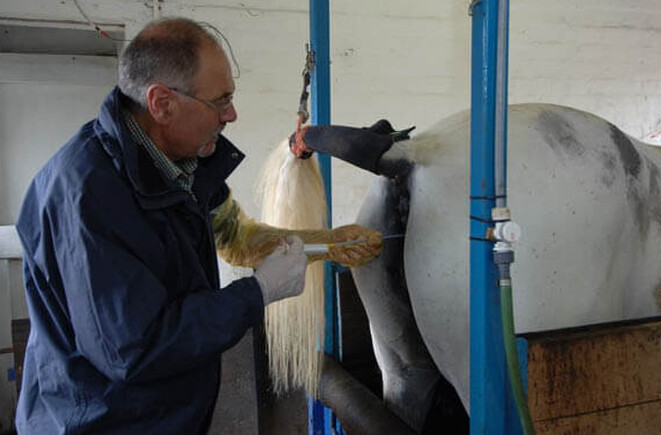Artificial insemination (or AI) is becoming more common in the equine breeding industry. Standardbreds are now fully serviced via chilled or frozen semen with sports horses following closely behind.
If you’re looking to breed, the first step is getting your mare scanned. This involves having adequate facilities such as stocks to restrain your mare for rectal examination.
The mare’s reproductive tract is examined by manual palpation and then via ultrasound to determine the breeding soundness of the mare and what stage she is at in her cycle. This examination will aid in planning the best timing for a successful insemination.
Your mare will usually be scanned every two days to check how her cycle is progressing. We are monitoring the follicles on her ovaries and the tone of her uterus. Follicles grow on the ovaries and once they reach a suitable size (38mm or over) she will be confirmed as ready to serve.
The mare will be given a drug (Deslorelin) to ensure ovulation. Ovulation is the act of the egg being released from the follicle into the oviduct. She will be then be inseminated approximately 36 hours after giving Deslorelin. Another scan will take place the day after insemination to ensure ovulation has occurred and to assess any fluid accumulation in the uterus. This can result from irritation from the semen.
The mare will be scanned at 16 days post ovulation for signs of pregnancy. She will then be checked again at 28 days and 42 days which is when we can check the foal for a heartbeat.
Twin conception in mares is reasonably common but is an unwanted event due to the low percentage of twin pregnancies making it to full term. Twins are identified at the 16 day scan and one twin will be reduced by squeezing and popping the embryo, allowing the singleton to now go on to full term as a healthy foal.
If there is no evidence of a foal at the 16 day or 42 day scan, there is one of two options. If there is no obvious reason for a negative scan the mare can be assessed for a future serving date. Otherwise further testing may need to be considered such as biopsy of the uterus to determine why she did not conceive.
Advantages of artificial insemination include:
- a larger range of stallions available for use over your mare
- less risk of injury to the mare and the stallion from the stallion and being able to intervene and more intensively manage mares with poor fertility.
Disadvantages of AI are an increased cost.
Chilled semen is viable for 24-48 hours after insemination of the mare whereas frozen semen lasts 6-12 hours. Therefore, when using frozen semen timing must be more exact. Pregnancy rates via chilled semen are 60-70% per cycle and frozen rates are 40-50% per cycle. The use of frozen semen is becoming more common due to using overseas or deceased stallions. It is also often less readily available.
If you are considering breeding your mare this season, please ring the clinic to book in or for a chat with one of our vets.

